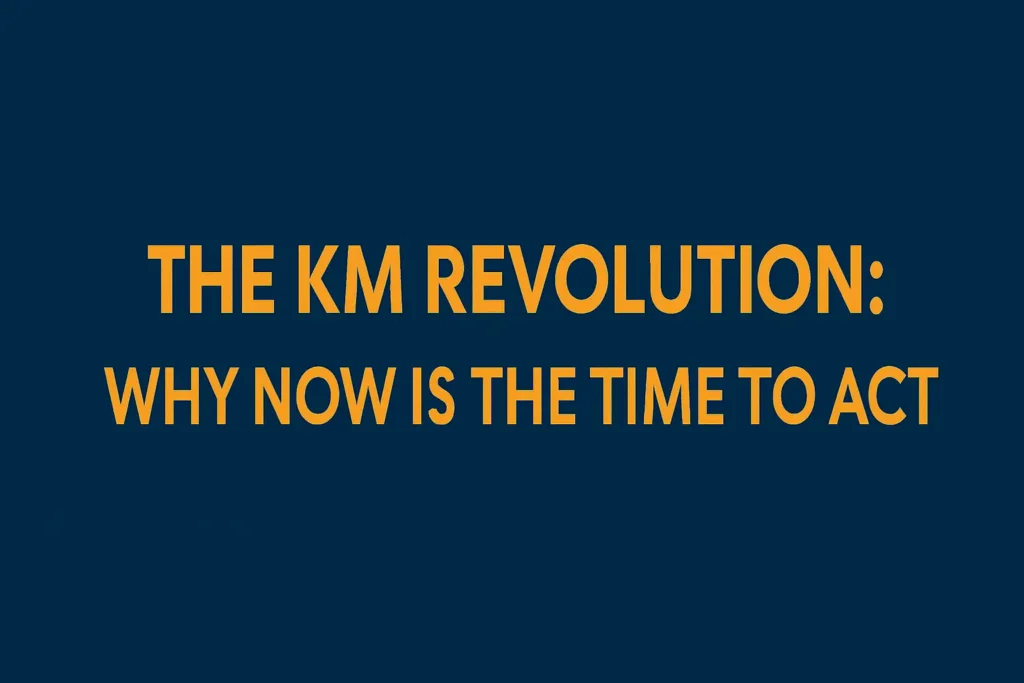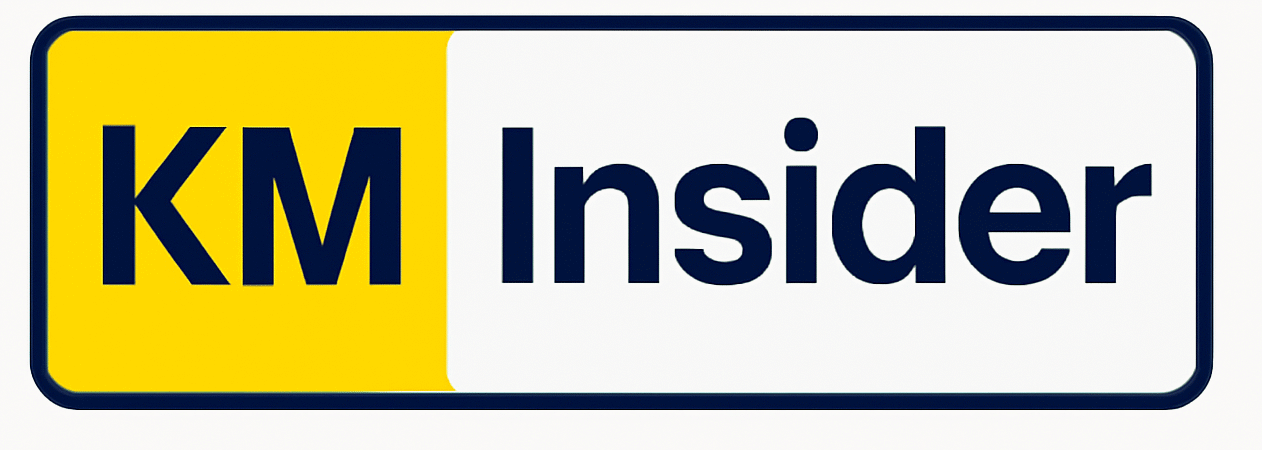The workplace has changed forever. What once was a predictable environment where knowledge lived in filing cabinets and experienced employees passed down wisdom through hallway conversations has transformed into something entirely different. Today’s organizations face unprecedented challenges in managing their most valuable asset: knowledge.
We’re living through what I call the KM Revolution, a fundamental shift in how organizations must approach knowledge management to survive and thrive. This isn’t just another business trend or consultant buzzword. It’s a critical transformation that demands immediate action from every leader who wants their organization to remain competitive.

The Crisis That’s Hiding in Plain Sight
Let’s start with some uncomfortable truths. Right now, your employees are spending 1.8 hours every day just searching for information they need to do their jobs. That’s more than 400 hours per year, per employee, lost to inefficient knowledge management. For a company with 150 employees earning $60,000 annually, this represents $750,000 in lost productivity every single year.
But the real crisis runs deeper than lost hours. The Great Resignation continues to impact organizations worldwide, and with it comes something even more devastating: knowledge hemorrhaging. When employees leave, they take with them years of accumulated wisdom, processes, relationships, and insights that can’t be easily replaced.
Research shows that replacing a single employee can cost up to 213% of their annual salary. But here’s what most leaders miss the hidden cost of knowledge loss often exceeds the visible cost of replacement. When your star performer walks out the door, they don’t just take their skills; they take the undocumented processes, the shortcuts that save time, the relationships that make deals happen, and the tribal knowledge that keeps operations running smoothly.
Companies lose $31.5 billion annually due to poor knowledge sharing, and a firm with just 1,000 employees can lose $2.4 million in productivity each year simply because knowledge isn’t flowing properly.
The Perfect Storm: Why Change Is Inevitable
Three massive forces are converging to create the perfect storm that’s driving the KM Revolution:
Digital Transformation Acceleration
The pandemic didn’t just change where we work—it fundamentally altered how we work. Organizations that took years to plan digital initiatives suddenly implemented them in weeks. This rapid transformation created new challenges:
- 54% of organizations now use more than 5 different platforms for documenting and sharing information
- Remote and hybrid work models have made traditional knowledge transfer methods obsolete
- 54% of remote workers feel disconnected from their colleagues, leading to decreased collaborative efficiency
Information Overload and Fragmentation
We’re drowning in data but starving for wisdom. The explosion of digital tools and platforms has created information silos that actually make knowledge harder to find and use:
- 47% of professionals spend 1-5 hours daily searching for specific information
- 36% of organizations have 3 or more KM tools in use, with 31% of employees not even knowing how many tools their company uses
- Only 6% of respondents can find 100% of the unstructured information they need
The Skills and Experience Gap
Baby Boomers are retiring at an unprecedented rate, taking decades of institutional knowledge with them. Meanwhile, younger workers expect immediate access to information and seamless digital experiences:
- Traditional apprenticeship models no longer work in remote environments
- Formal training programs can’t keep pace with the speed of change
- Knowledge transfer has become a strategic imperative, not just a nice-to-have
The AI-Powered Knowledge Revolution
Here’s where the revolution gets exciting. Artificial intelligence isn’t just changing knowledge management—it’s completely reimagining what’s possible.
Smart Knowledge Discovery
AI-powered systems can now automatically identify, categorize, and connect information across your entire organization. Instead of employees hunting through dozens of systems, AI brings relevant knowledge directly to them:
- Semantic search understands context and intent, not just keywords
- Knowledge graphs create intelligent connections between related information
- Predictive analytics anticipates what knowledge workers will need before they ask
44% of KM experts agree that generative AI is the most important technology for knowledge management. By 2025, AI-assisted content generation will become commonplace, with systems capable of drafting initial knowledge artifacts and summarizing complex information.
Personalized Knowledge Delivery
Modern KM systems powered by AI can understand individual roles, preferences, and work patterns to deliver personalized knowledge experiences:
- Sales teams receive AI-curated client insights relevant to their current deals
- Engineers get immediate access to technical documentation for ongoing projects
- Support agents see relevant troubleshooting guides based on customer issues
Automated Knowledge Capture
Perhaps most importantly, AI can now capture knowledge automatically as work happens:
- Meeting transcripts are automatically processed and key insights extracted
- Email exchanges are analyzed to identify valuable knowledge patterns
- Document interactions reveal which information is most valuable and frequently accessed
The Competitive Advantage of Acting Now
Organizations that embrace the KM Revolution now will gain significant competitive advantages over those that wait:
Operational Excellence
Companies that excel in knowledge sharing see a 25% increase in productivity compared to their peers. They also experience:
- 28.6% reduction in resolution time through better knowledge access
- Dramatic decreases in redundant work and duplicated efforts
- 38% higher employee engagement rates when organizations invest in collaboration tools and training
Innovation Acceleration
When knowledge flows freely across organizations, innovation flourishes:
- Cross-functional collaboration increases exponentially
- Best practices spread rapidly throughout the organization
- Learning from failures becomes systematic rather than accidental
Talent Retention and Attraction
Modern workers expect modern tools. Organizations with sophisticated knowledge management systems:
- Attract top talent who value efficient, well-organized work environments
- Reduce frustration and improve job satisfaction
- Create opportunities for continuous learning and growth
What the Leaders Are Doing Right Now
The most forward-thinking organizations aren’t waiting for perfect solutions—they’re acting decisively on multiple fronts:
Investing in AI-Powered Platforms
Leading companies are moving beyond traditional document repositories to AI-enhanced knowledge platforms that:
- Integrate seamlessly with existing workflows
- Provide contextual knowledge recommendations
- Learn from user behavior to improve over time
The AI-driven knowledge management market is projected to grow from $5.23 billion in 2024 to $7.71 billion in 2025—a staggering 47.2% growth rate.
Creating Knowledge-Centric Cultures
Technology alone isn’t enough. The most successful organizations are:
- Making knowledge sharing a core performance metric
- Rewarding employees who contribute valuable knowledge
- Building communities of practice around critical knowledge domains
- Allocating up to 6% of their budgets to training on digital collaboration tools
Implementing Comprehensive Knowledge Strategies
Rather than piecemeal solutions, leaders are taking holistic approaches:
- Conducting knowledge audits to identify critical gaps
- Mapping knowledge flows across the organization
- Creating redundancy for mission-critical knowledge
- Establishing governance structures for knowledge quality
The Roadmap: How to Join the Revolution
If you’re ready to act, here’s your strategic roadmap:
Phase 1: Assessment and Foundation (Months 1-3)
Conduct a Knowledge Audit
- Identify your organization’s critical knowledge assets
- Map current knowledge flows and gaps
- Assess existing tools and their effectiveness
- Survey employees about knowledge-related pain points
Establish Governance
- Create a knowledge management steering committee
- Define roles and responsibilities for knowledge stewardship
- Develop policies for knowledge creation, sharing, and retention
- Set measurable goals and success metrics
Phase 2: Technology Implementation (Months 4-9)
Select and Deploy Modern KM Tools
- Choose AI-powered platforms that integrate with existing systems
- Prioritize user experience and ease of adoption
- Implement search and discovery capabilities
- Create mobile-friendly access points
Migrate and Organize Existing Knowledge
- Clean up and consolidate scattered information
- Apply consistent tagging and categorization
- Create logical information architectures
- Establish content quality standards
Phase 3: Culture and Process Integration (Months 6-12)
Build Knowledge-Sharing Habits
- Integrate knowledge activities into daily workflows
- Create incentives for knowledge contribution
- Establish communities of practice
- Implement peer recognition programs
Measure and Optimize
- Track usage patterns and user satisfaction
- Monitor productivity improvements
- Adjust processes based on feedback
- Celebrate and communicate wins
The Risks of Waiting
While the benefits of acting are clear, the risks of inaction are equally important to understand:
Competitive Disadvantage
Organizations that lag in knowledge management will find themselves at significant disadvantages:
- Slower response times to market changes
- Inability to scale efficiently
- Higher operational costs due to inefficiency
- Difficulty attracting and retaining top talent
Knowledge Loss Acceleration
Every day you wait, more valuable knowledge walks out your doors:
- Retiring employees take irreplaceable experience with them
- High-performing employees leave for better-organized companies
- Critical processes become more fragmented and difficult to reconstruct
Increased Technology Debt
Legacy systems and processes become more expensive to change over time:
- Integration challenges multiply as systems age
- User resistance increases with prolonged exposure to inefficient tools
- The gap between current state and desired state widens
Your Call to Action
The KM Revolution isn’t coming—it’s here. Right now, your competitors are either gaining ground by embracing modern knowledge management or falling behind by ignoring it. The question isn’t whether you should act, but how quickly you can move.
Start this week by taking these immediate steps:
- Assess your current state honestly. How much time do your employees spend searching for information? How much knowledge have you lost in the past year due to turnover?
- Form a task force of stakeholders from across your organization. Include IT, HR, operations, and key business leaders.
- Set a budget for knowledge management initiatives. Remember, the cost of inaction far exceeds the cost of investment.
- Begin planning your knowledge management strategy using the roadmap outlined above.
- Communicate the vision to your entire organization. Help everyone understand why this matters and how they’ll benefit.
The organizations that thrive in the next decade will be those that master the art and science of knowledge management. They’ll be faster, smarter, more innovative, and more resilient than their competitors.
The revolution has begun. The only question is: will you lead it, follow it, or be left behind by it?
The time to act is now. Your organization’s future depends on the knowledge decisions you make today. Don’t let another day pass without taking concrete steps toward building a knowledge-powered organization that can compete and win in the modern economy.
The KM Revolution waits for no one. But for those ready to embrace it, the rewards are transformational.
